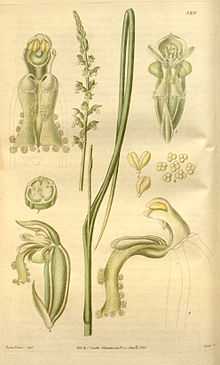Microtis media
| Microtis media | |
|---|---|
 | |
| Microtis media, Illustration. | |
| Scientific classification | |
| Kingdom: | Plantae |
| (unranked): | Angiosperms |
| (unranked): | Monocots |
| Order: | Asparagales |
| Family: | Orchidaceae |
| Subfamily: | Orchidoideae |
| Tribe: | Diurideae |
| Subtribe: | Prasophyllinae |
| Genus: | Microtis |
| Species: | M. media |
| Binomial name | |
| Microtis media R.Br. | |
| Subspecies | |
| |
Microtis media is a herbaceous plant of the family Orchidaceae. It is found in Western Australia, and informally known as the Tall - or Common - Mignonette Orchid or Middle-sized Microtis.
Description
This member of Microtis (Onion Orchids) occurs in southern regions of Western Australia, throughout the Southwest Botanical Province and the inland Coolgardie region.
They are deciduous, chlorophyllous, sympodial, tuberoid terrestrial orchids with a single, cylindrical leaf that encloses the stem.
The tiny flowers are green, arranged spiral in a spike or raceme around the erect and tall central stalk, and appear between September and January. The lowermost flowers are close the exit of the stalk from the sheating leaf. The dorsal sepal is sharp-pointed and forms a hood over the column. The lateral sepals are oblong and sometimes recurved. The dorsal sepal often keeps the oblong petals out of sight. The lip is ovate-oblong with united basal calli. The lobed lip has a rough, irregular margin.
The species was first described by Robert Brown in 1810,[1] from a specimen collected at King George Sound in 1801.[2] The plant was featured in Curtis's Botanical Magazine in 1825, where it was given the common name Middle-sized Microtis. According to Allan Cunningham it appeared from a sod of earth containing a Cephalotus, collected by Phillip Parker King from same location, and flowered to provide the source of the illustration by Franz Bauer. The description was "Whole plant, in general aspect, very much resembling the M. parviflora represented in our last plate, but more than twice the size. The flowers too are extremely similar, and the chief difference is to be found in the lip, which is here larger in proportion to the rest of the flower, and it is singularly wedge-shaped, truncated, and obtuse, even retuse at the extremity :–the disk being moreover furnished with two oblong, warty callosities, and the margin of the lower half and apex, with several globose, tuberculated processes".[3]
Two subspecies are currently recognised:[4] M. media subsp. media and M. media subsp. densiflora.
References
- ↑ Brown, R. (1810), Prodromus Florae Novae Hollandiae: 321
- ↑ "Microtis media R.Br.". Australian Plant Name Index (APNI), IBIS database. Centre for Plant Biodiversity Research, Australian Government.
- ↑ Cunningham, Allan; Bauer, Franz; et al. Curtis's botanical magazine, 62 Plate 3378
- ↑ "Microtis media R.Br.". FloraBase. Department of Environment and Conservation, Government of Western Australia.